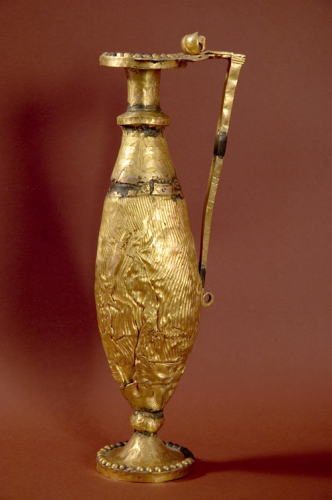Romania's Royal jewellery at the National History Museum treasury
 |
| The steel crown of Romanian Kingdom |
 |
| Gold bracelet received by Qeen Maria as a recognition of his participation at the diplomatic efforts for Romania's Reunification |
 |
| Bracelet received by Qeen Elisabeta as a recognition of his activity for Romanian Culture disemination |
 |
A portrait of King Carol I received as recognition of his contribution of Balkan peoples independence and emancipation
|
Famous Dacian Helmets at the National Museum of Romanian History
The main decoration,common for all helmets are the two front sacred eyes.The helmets are decorated also with sacred scenes or with symbols describing the ruler'victories,like on Peretu helmet. At the end of the IV century BC these little states begin an unification process in order to rezist to the foreing dangers of great empires (Persian, Alexandre and finally Roman).From this moment ,the golden helmet become the privilege of The Great Dacian King and no other local ruler can't have such one.The Cucuteni helmet have a particular importance,the dacian ruler grave location beeing near the Cucuteni civilisation centre from the bronze age(year4000BC),the first european culture,wich prouves the continuity of populations in this area.
 |
| Aghigiol helmet,IV centuryBC,silver and gold,Constanta county |
 |
| Orsova helmet,silver,Vcentury BC,Mehedinti county |
,Peretu.jpg) |
| Peretu helmet,IV century BC ,silver and gold,Teleorman county |
 |
| Cotofenesti helmet,IV century BC, gold,Prahova county |
 |
| Olanesti helmet,VI centuryBC, goldplated bronze,Vilcea county |
 |
Cucuteni helmet,V centuryBC, gold,Iasi county
|
- Dinogetia treasure at the National Museum of Romanian History
 |
| IX century |
 |
| VII century |
 |
| IX century |
 |
| VI century |
 |
| XII century |
- ,Apahida Treasure" at the National Museum of Romanian History - treasury ~
The treasure is made in the Vth century and was discovered in the village Apahida, region Cluj in the XX th Centry.
The exhibition is open for visits permanently acording to the Museums program.

~ ,,Pietroasa Treasure" at the National Museum of Romanian History - treasury
Surnamed "Golden Chick and hens" the treasure is made in the Vth century and was discovered in the village Pietroasa, region Buzau in the XIX th Centry.
The exhibition is open for visits permanently at the National History Museum of Bucharest.
~ ,,Dacian Gold" ~
at the National Museum of Romanian History - treasury
Female Idol 4000 BC
 Golden Daggers from 1700 BC
Golden Daggers from 1700 BC
Golden Dacian Necklace 1300BC
Aghigiol Treasure ~ Silver and Gold 400 BC
Peretru Treasure ~ Silver and Gold ~ 400 BC
Golden Bracelet ~ 100 BC
From the beginnings of metallurgy copper was produced massively but also silver and gold was a big treasure on what we call now Romanian territory. Romania's antique name was Dacia (in old indo-european language Daksha-the land of gods). The Dacian People were free people that lived in autonomous communities. The helmets shown above were a ceremonial symbol of leadership. In the 4th century BC this communities started to form a centralized kingdom. Their economical system changed from barter to money which were golden kossons. In the end, their precious gold turned into a curse because after 150 years of battles, the Romans conquered Dacia turning it into a Roman province.
for more information about the museum and the possibility of visiting the treasury see National Museum









,Peretu.jpg)









 Golden Daggers from 1700 BC
Golden Daggers from 1700 BC 
























However, the Romans claim that they looted in a single hoard 165 tons of gold and 300 tons of silver is accepted by some historians. This amount is perhaps credible in terms of the massive Dacian exploitation of precious metals in the Apuseni Mountains along with trade payments and tributes from abroad paid to Dacians. Also, its existence in one spot suggests that Dacian State had a central control of precious metal circulation.
ReplyDelete